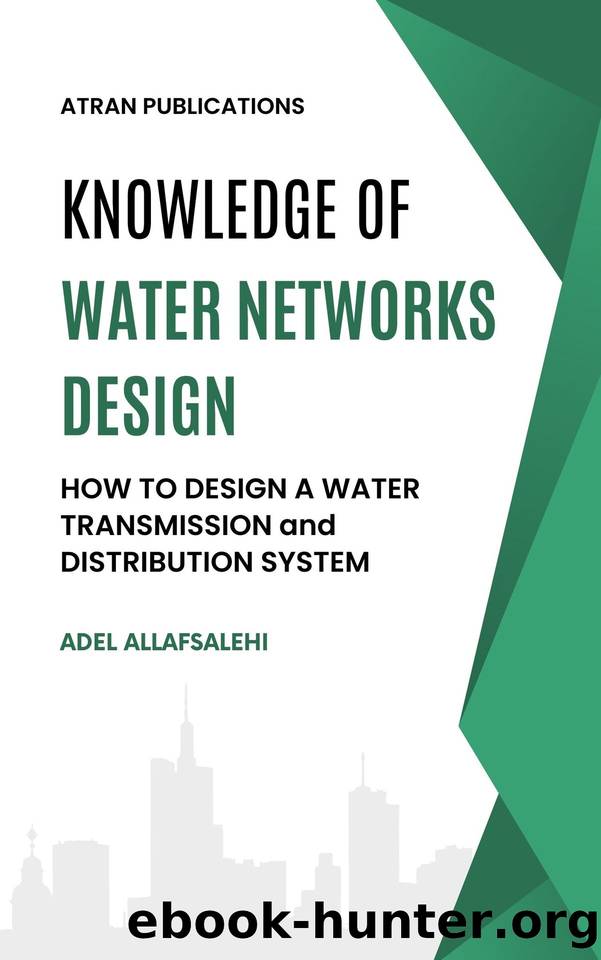KNOWLEDGE OF WATER NETWORKS DESIGN: HOW TO DESIGN A WATER TRANSMISSION and DISTRIBUTION SYSTEM by Allafsalehi Adel

Author:Allafsalehi, Adel
Language: eng
Format: epub
Publisher: UNKNOWN
Published: 2024-07-10T00:00:00+00:00
CHAPTER 6
Pipe Sizing and Selection
Introduction
Water pipe sizing and selection is a critical aspect of designing an efficient and reliable water distribution system. The process involves determining the appropriate diameter and material for pipes to ensure adequate flow rates, pressure levels, and system durability. Proper pipe sizing and material selection are essential not only for the smooth operation of water supply systems but also for costeffectiveness, sustainability, and long-term maintenance. Importance of Proper Pipe Sizing
The sizing of water pipes affects several key parameters of a water distribution network:
1. Flow Rate: The diameter of the pipe influences the volume of water that can pass through it. Undersized pipes may restrict flow, leading to insufficient water supply, especially during peak demand periods. Conversely, oversized pipes, while less likely to impede flow, can result in higher installation costs and potential issues with water quality due to prolonged water retention times.
2. Pressure Management: Adequate pressure is crucial for the effective delivery of water throughout the network. Properly sized pipes help maintain desired pressure levels, reducing the risk of both high-pressure damage to pipes and low-pressure issues that can impair water supply to end users.
3. Energy Efficiency: Pumping water through an optimally sized pipe requires less energy compared to pumping through an undersized pipe, where friction losses are higher. This can result in significant energy savings over the life of the system.
4. Operational Costs: Correct pipe sizing minimizes maintenance and operational issues. For instance, pipes that are too small are more prone to blockages and wear out faster, while oversized pipes represent a waste of resources and higher initial costs.
Factors Influencing Pipe Sizing
Several factors must be considered when sizing water pipes:
1. Water Demand: Estimating the current and future
water demand is fundamental. This includes considering peak usage times, population growth, and potential changes in water usage patterns.
2. Pipe Length and Layout: The distance water needs to travel and the complexity of the network layout (including the number of bends, valves, and fittings) affect the pressure losses and flow rates, influencing the required pipe diameter.
3. Elevation Changes: Variations in elevation within the service area impact pressure and flow. Gravity can assist or hinder water movement, necessitating adjustments in pipe sizing to compensate for these changes.
4. Friction Losses: The internal roughness of pipe materials causes friction, which reduces pressure. Calculating friction losses using methods such as the Hazen-Williams or Darcy-Weisbach equations helps determine the optimal pipe size.
Pipe Material Selection
Selecting the appropriate material for water pipes is equally important as sizing. Material choice impacts durability, maintenance, and overall system performance. Common materials include:
1. PVC (Polyvinyl Chloride): Lightweight, corrosionresistant, and easy to install, PVC is popular for many types of water distribution systems. However, it is less suitable for high-pressure applications.
2. Ductile Iron: Known for its strength and durability, ductile iron is ideal for high-pressure areas and provides excellent resistance to impact and corrosion when properly coated.
3. HDPE (High-Density Polyethylene): Flexible and resistant to a wide range of chemicals, HDPE is increasingly used in modern water systems, particularly for its resistance to cracking and ease of joining.
Download
This site does not store any files on its server. We only index and link to content provided by other sites. Please contact the content providers to delete copyright contents if any and email us, we'll remove relevant links or contents immediately.
| Automotive | Engineering |
| Transportation |
Whiskies Galore by Ian Buxton(41704)
Introduction to Aircraft Design (Cambridge Aerospace Series) by John P. Fielding(33008)
Small Unmanned Fixed-wing Aircraft Design by Andrew J. Keane Andras Sobester James P. Scanlan & András Sóbester & James P. Scanlan(32676)
Craft Beer for the Homebrewer by Michael Agnew(18068)
Turbulence by E. J. Noyes(7884)
The Complete Stick Figure Physics Tutorials by Allen Sarah(7253)
Kaplan MCAT General Chemistry Review by Kaplan(6806)
The Thirst by Nesbo Jo(6744)
Bad Blood by John Carreyrou(6464)
Modelling of Convective Heat and Mass Transfer in Rotating Flows by Igor V. Shevchuk(6345)
Learning SQL by Alan Beaulieu(6148)
Weapons of Math Destruction by Cathy O'Neil(6069)
Man-made Catastrophes and Risk Information Concealment by Dmitry Chernov & Didier Sornette(5862)
Digital Minimalism by Cal Newport;(5570)
Life 3.0: Being Human in the Age of Artificial Intelligence by Tegmark Max(5391)
iGen by Jean M. Twenge(5290)
Secrets of Antigravity Propulsion: Tesla, UFOs, and Classified Aerospace Technology by Ph.D. Paul A. Laviolette(5229)
Design of Trajectory Optimization Approach for Space Maneuver Vehicle Skip Entry Problems by Runqi Chai & Al Savvaris & Antonios Tsourdos & Senchun Chai(4946)
Electronic Devices & Circuits by Jacob Millman & Christos C. Halkias(4857)
